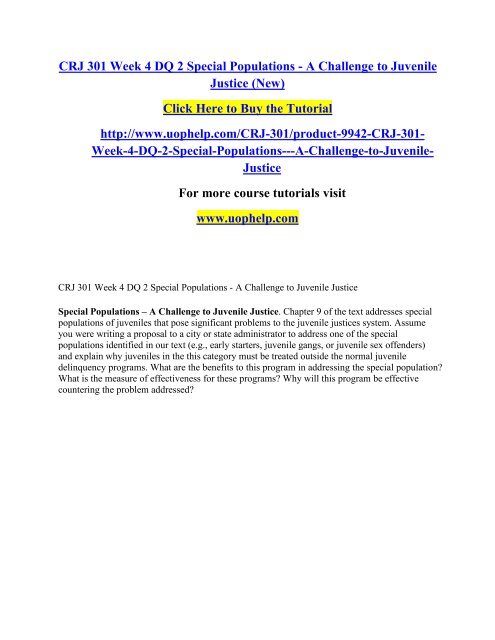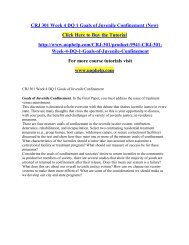CRJ 301 Week 4 DQ 2 Special Populations - A Challenge to Juvenile Justice (New)
For more course tutorials visit www.uophelp.com CRJ 301 Week 4 DQ 2 Special Populations - A Challenge to Juvenile Justice Special Populations – A Challenge to Juvenile Justice. Chapter 9 of the text addresses special populations of juveniles that pose significant problems to the juvenile justices system. Assume you were writing a proposal to a city or state administrator to address one of the special populations identified in our text (e.g., early starters, juvenile gangs, or juvenile sex offenders) and explain why juveniles in the this category must be treated outside the normal juvenile delinquency programs. What are the benefits to this program in addressing the special population? What is the measure of effectiveness for these programs? Why will this program be effective countering the problem addressed?
For more course tutorials visit
www.uophelp.com
CRJ 301 Week 4 DQ 2 Special Populations - A Challenge to Juvenile Justice
Special Populations – A Challenge to Juvenile Justice. Chapter 9 of the text addresses special
populations of juveniles that pose significant problems to the juvenile justices system. Assume you were writing a proposal to a city or state administrator to address one of the special populations identified in our text (e.g., early starters, juvenile gangs, or juvenile sex offenders) and explain why juveniles in the this category must be treated outside the normal juvenile delinquency programs. What are the benefits to this program in addressing the special population? What is the measure of effectiveness for these programs? Why will this program be effective countering the problem addressed?
- No tags were found...
Create successful ePaper yourself
Turn your PDF publications into a flip-book with our unique Google optimized e-Paper software.
<strong>CRJ</strong> <strong>301</strong> <strong>Week</strong> 4 <strong>DQ</strong> 2 <strong>Special</strong> <strong>Populations</strong> - A <strong>Challenge</strong> <strong>to</strong> <strong>Juvenile</strong><br />
<strong>Justice</strong> (<strong>New</strong>)<br />
Click Here <strong>to</strong> Buy the Tu<strong>to</strong>rial<br />
http://www.uophelp.com/<strong>CRJ</strong>-<strong>301</strong>/product-9942-<strong>CRJ</strong>-<strong>301</strong>-<br />
<strong>Week</strong>-4-<strong>DQ</strong>-2-<strong>Special</strong>-<strong>Populations</strong>---A-<strong>Challenge</strong>-<strong>to</strong>-<strong>Juvenile</strong>-<br />
<strong>Justice</strong><br />
For more course tu<strong>to</strong>rials visit<br />
www.uophelp.com<br />
<strong>CRJ</strong> <strong>301</strong> <strong>Week</strong> 4 <strong>DQ</strong> 2 <strong>Special</strong> <strong>Populations</strong> - A <strong>Challenge</strong> <strong>to</strong> <strong>Juvenile</strong> <strong>Justice</strong><br />
<strong>Special</strong> <strong>Populations</strong> – A <strong>Challenge</strong> <strong>to</strong> <strong>Juvenile</strong> <strong>Justice</strong>. Chapter 9 of the text addresses special<br />
populations of juveniles that pose significant problems <strong>to</strong> the juvenile justices system. Assume<br />
you were writing a proposal <strong>to</strong> a city or state administra<strong>to</strong>r <strong>to</strong> address one of the special<br />
populations identified in our text (e.g., early starters, juvenile gangs, or juvenile sex offenders)<br />
and explain why juveniles in the this category must be treated outside the normal juvenile<br />
delinquency programs. What are the benefits <strong>to</strong> this program in addressing the special population?<br />
What is the measure of effectiveness for these programs? Why will this program be effective<br />
countering the problem addressed?
















